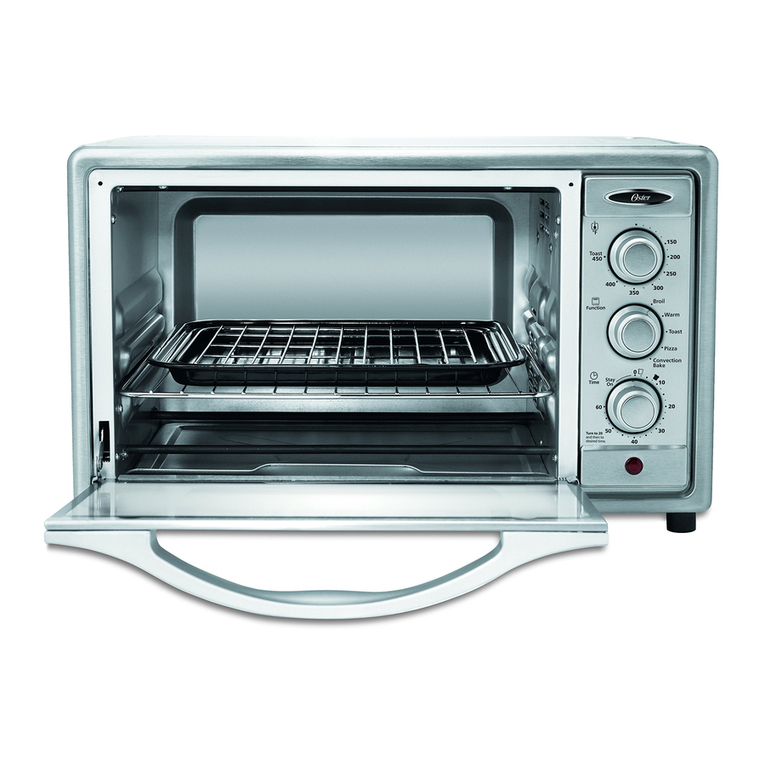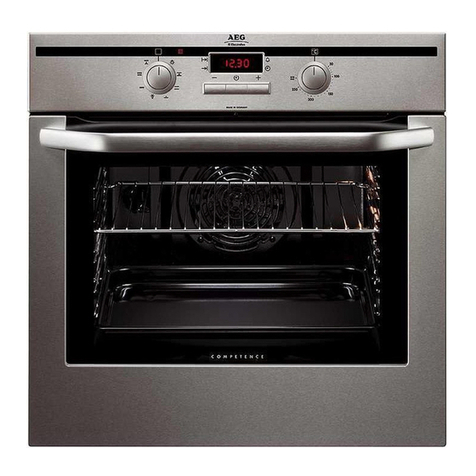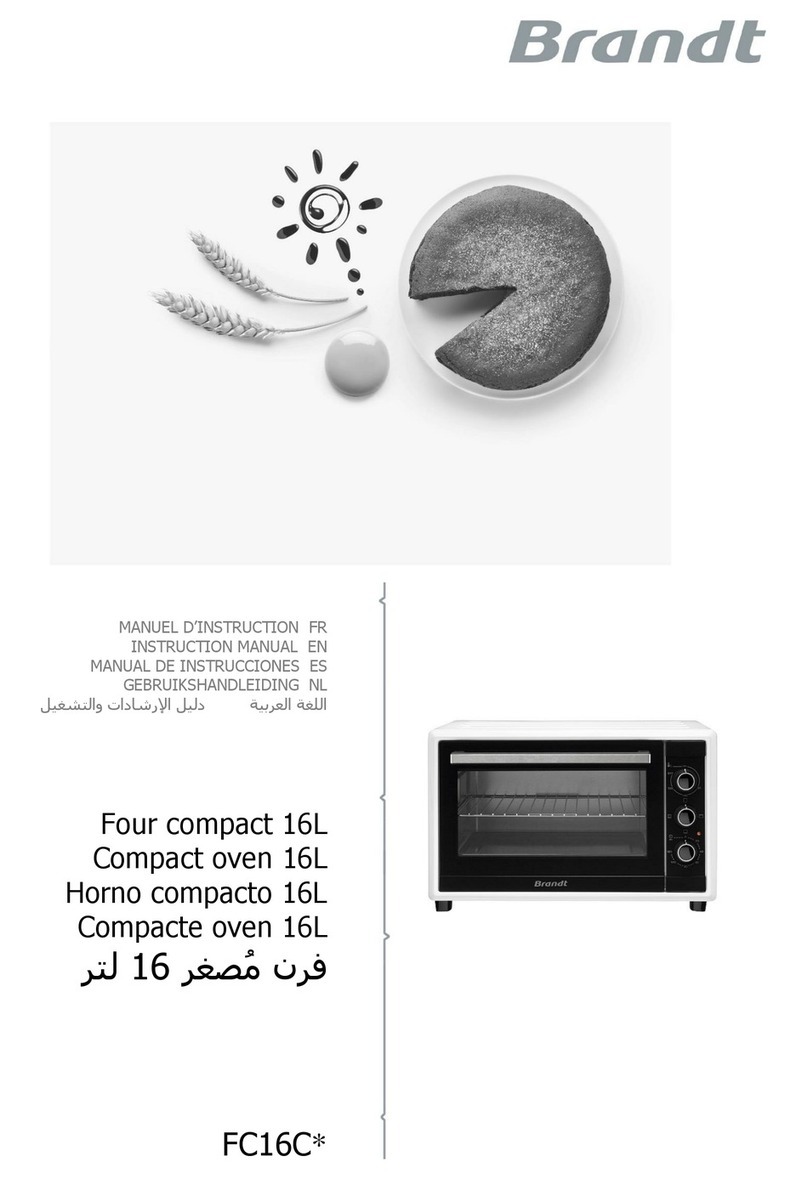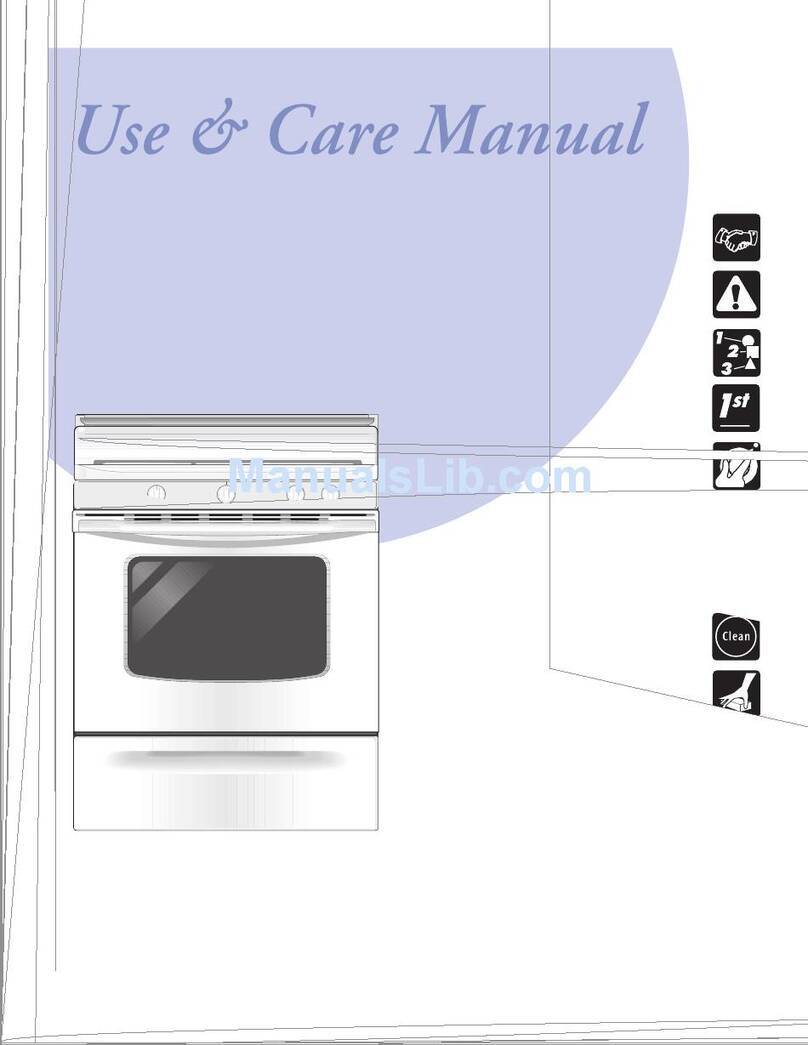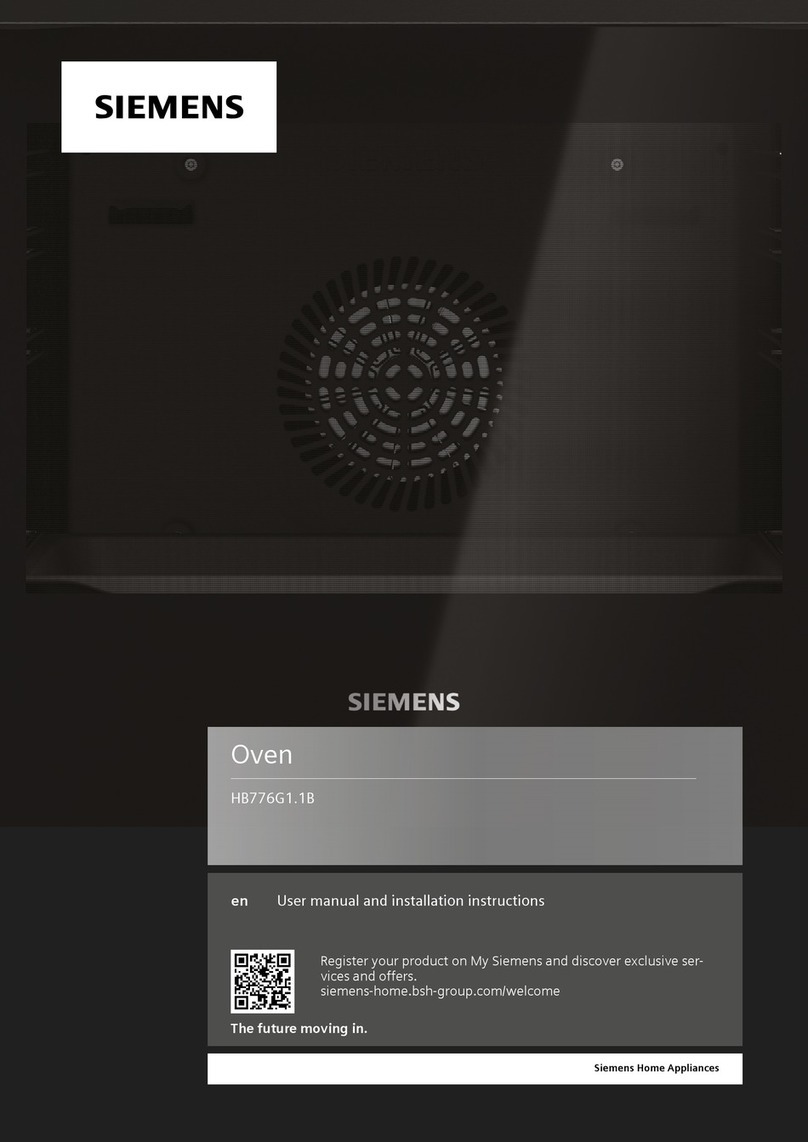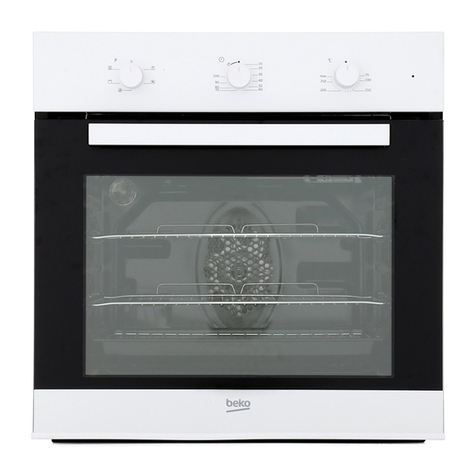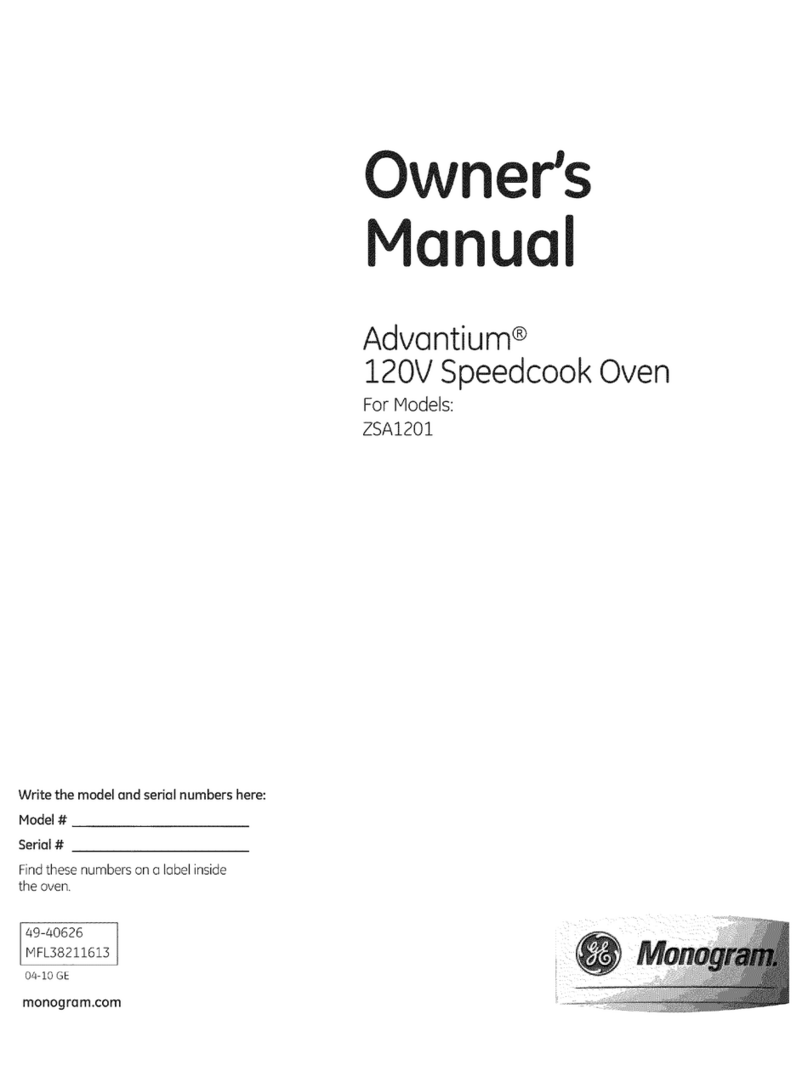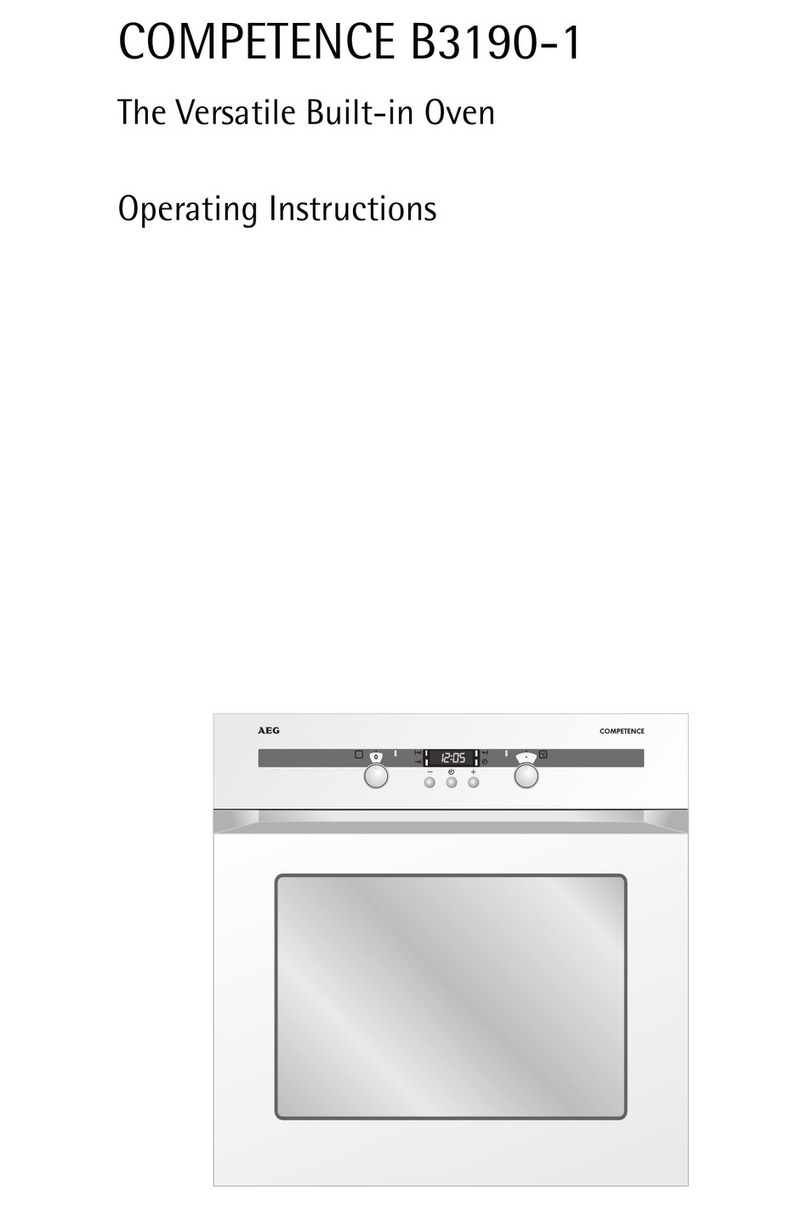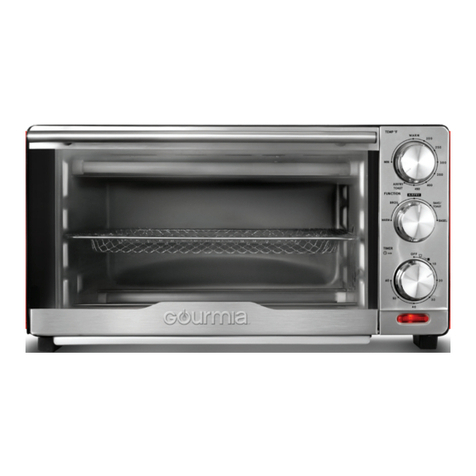Elastocon EB 19 User manual

Manual
Cell Ageing Oven EB 19, EB 20
© 2010–2019, Elastocon AB, SWEDEN
Contents
1. Setting up the Cell Ageing Oven p. 2
2. Running the Cell Ageing Oven p. 2
3. Programming of cycling temperatures p. 9
4. Temperature calibration p. 17
5. Service and maintenance p. 17
6. Troubleshooting p. 17
7. Safety p. 17
8. Technicalspecication p. 18
Technical documentation supplied
on USB flash drive
ma-eb19-20_08_1911
Elastocon AB •Tvinnargatan 25 •SE-507 30 Brämhult •Sweden

2
Elastocon Manual – Cell Ageing Oven EB 19, EB 20
1. Setting up the Cell Ageing Oven
Place the Ageing Oven on a stable and horizontal bench.
Connect the oven to a grounded mains outlet, according to the type label
on the oven. We recommend the use of an Earth Leakage Detector.
2. Running the Cell Ageing Oven
2.1 Starting
Switch on the power (red switch).
Reset the power failure and alarm, see 2.2.4 and 2.2.6.
Set the temperature on the PLC, see 2.2.1.
2.2 Settings
Explanation
1. Date & time
2. Countdown time left
3. Countdown timer on or off
(off in this example)
4. Test name
5. Power Failure
6. Alarm and History – tap this symbol
and the alarm history will be visible
on the PLC screen
7. SCS – multiple cells will be shown as
slides shifting in a sequence with
enlarged displays
8. Set up for
• date & time
• communication with software
• calibration offset
9. Alarm Buzzer on or off
10. PV = Process value – the actual
temperature in the cells
11. SV = Set value – the temperature set for this cell
The oven has a touch controlled screen. A touch pen will be included
Note: Do not use sharp objects to touch the screen.
This can cause damage on the screen.
1110
8
3
4
2
5
9
1
67

3
Elastocon Manual – Cell Ageing Oven EB 19, EB 20
2.2.1 Temperature setting
Tap on the ”SV” box (Set value) to set the test temperature
(Fig 2.2.1a).
A numeric keyboard will show. Type in the set temperature
withthenumerickeyboardandnishwithataponthe
return button (Fig 2.2.1b).
Or use the panel keys to mark the SV display and
adjust the temperature setting.
Press the arrow down or up to mark the SV box and
then use the arrow key left and right to adjust the value.
The ”PV” box is an indicator and shows the present
temperature in the oven.
2.2.2 Test name (Fig 2.2.2)
Press the grey box labeled Test name, on the main screen.
Type the test name from the touch screen keyboard. One test
name row on the screen can hold up to 40 characters.
1. Use the white arrow keys on the upper left corner to swap
between different keyboard character layouts.
2. TapontheEnterkeytonalizethetestnameinput.
3. To re-enter any character on the same test name row,
it is possible to correct any character in the test name with
a tap on any of the white left or right arrow buttons in the
lower left and right corner on the screen.
4. To cancel any input changes, tap on the ESC key and
return to the previous screen.
2.2.3 Test time
In the ”Time” box (h:m left) to the right of each cell a count-
down time can be typed in (Fig 2.2.3). Tap the box, type in the
time and press Return. The time will now start countdown.
This time can only be changed when the time symbol to the
right is disabled. Press the symbol for at least 2 seconds and
a red line is shown. The time can now be changed.
This function can also be used if the user don’t want
the countdown to start immediately. Press the symbol
for at least 2 seconds until the red line is shown. Click the
“Time” box, type in the time and press enter. When the
countdown should start press the symbol (again >0 sec) until
the red line disappears.
The countdown will now start. Time can also be changed by
marking hours and use the arrows left and right.
Fig 2.2.1a Temperature setting
Fig 2.2.1b Temperature setting
Fig 2.2.2 Test name
Fig 2.2.3 Test time

4
Elastocon Manual – Cell Ageing Oven EB 19, EB 20
2.2.4 Power failure
Power failure during a test
If the test time is running when a power failure occurs, the
oven temperature and test time counters will continue from
the time when the power failure occurred, when the power is
resumed.
Power failure indicator
When the power is resumed after a power failure during
a test with temperature control at set point and test timer
running, the screen will lit up a power failure button.
Tap on the Power Failure button to see more information
and to reset the power failure (Fig 2.2.4a).
A new screen will show (Fig 2.2.4b).
This feature will give the operator information about
duration of the power failure and temperature drop caused
by the power failure. The power failure button will remain
until the button Clear & Exit is tapped.
2.2.5 Set up screen (user)
Password
A password is needed to enter the set up mode.
Tap on the Setup button on the main screen to enter the
password screen for set up.
Default password is: 1111
Fig 2.2.4a Power failure
Fig 2.2.4b Power failure
Fig 2.2.5 Password

5
Elastocon Manual – Cell Ageing Oven EB 19, EB 20
IP-address
In the Set up mode an IP-address can be typed in to establish
a communication with a PC-software e.g. monitoring
program. Tap on the IP-addr.eldtoenteranIP-address.
The IP-addr.eldisdividedintosmallerelds.
The oven main power must be switched off and on (restart)
for the IP settings to refresh and initiate.
Temperature offset
In the set up mode the offset is adjusted according to
calibration. When a re-calibration is done, values may have
to be adjusted again.
An individual offset value can be added to both the
temperature-indicator and -controller.
Standby temperature
The operator can in this Set up also preset a standby
temperature. That means when the test timer has reached
0:00, the oven will be set to this pre-set temperature. To
access the standby temperature setting, tap on the control
box below Stdby.
A zero value in this control means that it is not active and
after the test timer timeup the oven will remain at the same
temperature as during the test.
A higher value than zero represents the temperature
set value. Eg. if the operator sets the standby control to 30,
the oven will go to 30 °C after the test time has reached the
end. Minimum set value (SV) for the oven is 30 °C.
The oven has no cooling. The temperature will just cool off
naturally. The cooling time depends on the room ambient
temperature.
Real time clock
Tap on the real time clock control to set time and date.
This is the system time and date and this time/date stamp
will be included to all alarm and time critical information
visible on the screen.
Use the numeric keyboard to set a new time and date.
Fig 2.2.5 IP-address
Fig 2.2.5 Standby temperature 1
Fig 2.2.5 Standby temperature 2
Fig 2.2.5 Real time clock

6
Elastocon Manual – Cell Ageing Oven EB 19, EB 20
2.2.6 Alarm
Alarm is activated at:
• high temperature in the test chamber, + 1 °C from set value
• low temperature in the test chamber, - 1 °C from set value
• high temperature of the controller, + 5 °C from set value 1)
1) This alarm will be reset automatically when the temperature is within tolerance from set value again.
Error code Problem cause Remedy
001–006 Oven cell is too warm. The alarm will be reset when the alarm
Cell 1–6 has been acknowledged and the cell
has cooled down.
007–012 Temperature difference between Wait until the temperature is within
Cell 1–6 set value and process value ± 1 °C. range to acknowledge the alarm.
013 Lowpressurefromairpump. Checktheairpumplterandfunction.
014 Shinko Communication Timeout. Contact support.
015 Low battery. Replace backup battery in OPLC
(contact support).
016–021 Loop break controller #. Broken temperatur sensor,
Cell 1–6 call for service.
022–027 Temperature difference Acknowledge the alarm.
Cell 1–6 between set value of controller When temperature is within range
and actual value + 5 °C. the alarm will be reset. If the alarm
is not reset contact support.
Coloured lines on PV and SV display indicates alarm status.
• A red line above PV display = PV temperature differs + 1 °C from SV temperature.
• A light blue line below PV = PV temperatures differs - 1 °C from SV temperature.
• A red line above SV = SV differs + 5 °C from actual controller temperature.
• A green line below SV = PV temperature is within ± 1 °C from SV temperature.
SV temp. diff. alarm to general alarm collection list and ashing alarm button
will only be active for running channels (active count down meter).

7
Elastocon Manual – Cell Ageing Oven EB 19, EB 20
Alarmwillactivateabuzzerand/oraashingredAlarmbutton.
The buzzer can be switched on and off by a tap on the buzzer
symbol.
Ifthealarmbuttonstartstoash,gothroughthechecklist
in chapter 2.2.6 Alarm to identify the alarm and address the
problem for proper action.
Buzzer on Buzzer off
Acknowledge any alarm
To acknowledge any alarm, tap on the button Alarm.
Fig 2.2.6a. All active alarms can be seen on this screen. Press
the magnifying glass to the right side of the alarm ID 00 in the
alarm group list to view all active alarms in that group.
This oven will present all active alarms in the group named
ID 00.
All the alarms in this group are divided into two levels
depending on how serious the alarm is.
First level will reset the alarm automatically, but still requires
an acknowledgement to be cleared from the alarm list.
Second level must always be acknowledged by the operator
manually.
Fig 2.2.6b. To acknowledge an alarm, press the magnifying glass
to the right of the chosen alarm.
Fig 2.2.6c. Press the button Ack and the alarm will be reset.
Any alarm that is reset automatically will remain in the alarm
list until a normal condition is met. The red Alarm button will
howeverswitchfromashingtoaxedstate.
Alarm that still persists will show up again after the
acknowledge procedure.
Press the Esc button several times to return to main screen.
The History button will show a record of all previous alarm.
Fig 2.2.6a
Fig 2.2.6b
Fig 2.2.6c

8
Elastocon Manual – Cell Ageing Oven EB 19, EB 20
2.2.7 Set the air change rate
According to standards the air has to be changed during the
test. ISO 188 Accelerated ageing, method A, requires an air
change of 3 to 10 times an hour.
IEC 811 Ageing of cable insulation, requires an air change
rate of 8 to 20 times an hour.
The cells in the oven have a volume of 2,4 l/cell.
Thisgivesthefollowingowofairthroughtheowmeters:
air change rate
changes/h l/min
3 0,12
5 0,2
7,5 0,3
10 0,4
12 0,5
15 0,6
17,5 0,7
20 0,8
Forageingofrubbermaterialsitissuggestedtosettheow-
meters to 0,3 l/min.
For ageing of cable insulation materials it is suggested to set
theowmetersto0,6l/min.
Readtheowoftheowmetersatthecenteroftheoats.
Theoatsshallrotateslowlytoshowthecorrectreading.
Note:Iftheoatsdoesnotrotateproperlycheckiftheoven
is placed horizontally.
2.3 Start the test
When the test temperature is reached, take up the test piece
holders and place your samples on the pins, then return the
sample holders in the cells. Be careful when placing the lid
of the test piece holder, to achieve a good contact with the
aluminium block of the oven.

9
Elastocon Manual – Cell Ageing Oven EB 19, EB 20
Figure 3
3. Programming of ramp with cycling temperatures
Programming of cycling
temperatures/ramp is an additional
option except for:
1. EB 17
2. ES 07-II
These exceptions will have the ramp
option as default.
If this addition is included in the oven
the ramp button will be visible on the
main screen.
A temperature cycle is divided into
segments. Each segment is known in
this chapter as a ramp.
The ramp can be set within the same
temperatureintervalasspeciedfor
the oven. The ramp is built up by 2 break points
known as legs. There are 50 legs available to build
ramps and create a full temperature cycle. See
illustration on the next page (Leg-Ramp-Cycle).
Each leg can be used to set a new temperature or
maintain the same temperature over a time period
(duration). Duration up to 999 hours and 59 minutes,
can be set to each leg.
Ramp button
Press the ramp button to enter the ramp function.
This button can be found on the main screen.
Legs
Ovens with more than one individually controlled
temperature cell or chamber will have 50 legs
available for each temperature cell or chamber.
Each leg consists of a time control (Time h:m) and
one temperature set point control (Final Temp). An
optional button [ON/off] is included to some ovens.
The ON/off buttons will be described further on.
Leg at start of temperature cycle
If the temperature in the header (Temp) for the
instrument is equal to the temperature set point in
leg 1, that same temperature will be kept over the
time duration set in leg 1.
On the other hand, if the temperature set value for
theovenislowerorhigherthanthersttemperature
set point in leg 1, the temperature will increase/
decrease towards the temperature set point typed in
the leg 1 control. The temperature increase/decrease-
speed will be calculated to last over the time duration
set in leg 1.

10
Elastocon Manual – Cell Ageing Oven EB 19, EB 20
3.1 Leg when temperature cycle
is running
Whentherampisstarted,eachleglledwith
information will be processed. Legs with time settings
0:00 will not be processed and will be skipped.
If the temperature set value in a leg (Final Temp) is
equal to the temperature set point in the following
leg, the same temperature will be kept over the time
duration set in the following leg.
On the other hand, if the temperature set value for
the leg is lower or higher compared with the following
leg, the temperature will increase/decrease towards
the temperature set point typed in the following leg
control. The temperature increase/decrease -speed
will be calculated to last over the time duration set in
the following leg.
Ramp speed tolerances can be found in the speci-
cationsfortheinstrument.
The essential part of the leg
function is that if the following
leg is set with a different
temperature (set value) than
the previous leg, a ramp in
temperature will be created.
The duration for the ramp
is always controlled by the
following leg.
Button next
Press the button Next to show additional 13 legs
available for the same temperature cell/chamber.
There are three Next screens. A total of 50 legs are
available.
Ramp
Cycle
Leg

11
Elastocon Manual – Cell Ageing Oven EB 19, EB 20
Button [ON/off] (optional)
This button is available on some instruments that
require any type of mechanical action such as open/
close valves for additional cooling or heating. These
buttons are not visible if the instrument does not
have this option. The button is included to each leg
clusterandwillonlytakeactionwhenthespecicleg
is running and a time has been set for that leg.
Pressthebuttontogiveitaxstate.
ON = will activate the output (valve or control will be
switched on when this leg is running).
off = no action will be taken and the output will
remain off (valve or control will be switched off
when this leg is running).

12
Elastocon Manual – Cell Ageing Oven EB 19, EB 20
Ramp view header
Theheaderislocatedontherstrampscreen.The
header consists of one Play (start) button, Current
lap, Temp, Laps and Total [h:m].
The PLAY (start) button will execute the full
temperature cycle(s). To start the temperature cycle,
press the button PLAY. The play button will change it
appearance to a stop button.
An additional button will now also appear. This
button is the PAUSE button. Press the Pause button
to pause the ramp. In this state the temperature will
stop at the current processed set value. Press the
Pause button again and the temperature ramp will
continue.
To stop the ongoing cycle, press and hold the STOP
button pressed until the process is stopped (about
3 seconds).
Current lap is an indicator.This indicator
will show the current lap that is beeing
processed.
When the temperature cycle is started, the
Current lap indicator will show the current
processing lap.
The Temp control is the same control
as the set value (SV) control on the main
screen of the instrument.
This control will also act as an indicator
when the temperature cycle is started. The
operator can then follow the temperature in
this control as the cycle proceeds.
The Lap(s) is a control where the operator
can set up a number of repetitions for the
cycle.
Total [h:m] will calculate the total time of the
temperature cycle. The time settings for each leg will
be summed up. This time value is then multiplied by
the number of laps typed in the header control laps
to give the total time for the temperature cycle(s).
The Total [h:m] indicator will show the remaining
time for the full temperature cycle(s), when the
temperature cycle is running.
For some software versions, the total time cannot
show more than 9999 hours. In these cases, the
indicator will show xxxx. The function will remain
normal, but the total time is not possible to show.
Play
Pause Stop

13
Elastocon Manual – Cell Ageing Oven EB 19, EB 20
3.2 How to Store/Use
a programmed ramp
The total ramp generated can be stored into a
memory Bank.
There are six individual memory banks to choose
from.
Any stored ramp can be used for any heater cell/
chamber in the same oven, if the oven has more
than 1 heater cell/chamber.
The ramp program is write-protected and must be
temporary unlocked to edit the ramp data or store a
programmedramptole.
ES 07-II
Locked state is indicated with the word Locked on the
main screen.
Any other oven
Locked state is only indicated by disabled input
controls on the ramp screen.
In the locked state, any pre-stored ramp can still be
selected when the ramp screen is opened. Refer to
point USE in this chapter.
The ramp edit mode will remain open until the ramp
screen is closed and 1 minute has passed.
Store
Noticethatthelenameforthestoredrampisxed
andthelenamesarealways“RampDat1forBank1”,
“RampDat2 for bank 2” and so on.
Thestorebuttonwillsavethecurrentrampintoale
on the onboard SD micro card.
Iftheleislocked,thenreadthedescriptionbelow
from point 1.
Iftheleisun-locked,thenreadthedescription
below from point 5.
1. From the main screen, press the button Setup.
2. Enter password 1111+Enter.
3. Press the button Options (not for instrument
EB 17).
4. Tick the box Temporary unlock Ramp Store/Use
button.
5. Return to the main screen and press the RAMP
button.
6. Prepare the ramp as wanted with temperature and
time.
The temporary unlock will stay unlocked while
stepping between any of the four Channel Ramp#
screens.
When changing to another screen except these,
the temporary unlock will be cancelled and after
2 minutes the Store/Use button will then be
locked automatically.
7. Press the button Store/Use.
8. If any memory Bank is empty, type in a new
lenameandpressitsStore button.
If a memory Bank is occupied, Press its Store
buttonandchooseto“overwrite”theoldle.
Anewlenamecanbegivenatalltimebefore
pressing the Store button.

14
Elastocon Manual – Cell Ageing Oven EB 19, EB 20
Use
The Use button will connect any of the ramps stored
in any of the six memory banks to the Channel ramp
in use.
If the oven has more than one temperature cell/
chamber, any of these cells/chambers can be
connected to any of the memory banks.
1. From the Ramp screen press the button Store/
Use.
2. Press the button Use on any of the memory Banks.
3. Press the physical key ESC to return to the Ramp
screen.
4. TheleselectedwillnowbeloadedtotheChannel
in use.
If the oven has more than one cell or chamber
a matrix will be visible on the right side of the
Store/Use buttons.
This matrix will show each channel and if it is
connected to a ramp.
The maximum number of cells/chambers is six.
The example below shows that oven cell 1 was edited
(Administrate Ramp for Channe1) and ramp in
“Bank1” is currently in use for this oven cell and so is
the oven cell 6.
Oven cell 2 is using ramp data from “Bank2” and so
is oven cell 4, oven cell 3 is using ramp data from
“Bank3”, oven cell 5 is using ramp data from “Bank5”.

15
Elastocon Manual – Cell Ageing Oven EB 19, EB 20
Quick guide to initiate a ramp
(temperature cycle) and run it.
1. From the main instrument windows press the
ramp button symbol.
2. Fill in the header controls Temp and Laps.
Temp is the standby temperature before the ramp
(temperature cycling) is started and Laps
multiplies the number of cycles to run.
3. Fill in the Time and Final temp for a number of
legs to build all individual ramps in a full
temperature cycle. Nine legs are available in the
rstrampscreen.Another13legscanbeinitiated
in the next ramp screen. Press the button Next to
enter the next ramp window. Four screens are
available. First screen has 11 legs and the following
screens have 13 legs per screen. 50 legs in total.
Event buttons [EV]
(visible on instruments with this option)
To activate the event output, click and set the
event ON for each leg that is supposed to activate
the event output. Instruments with the LTP option
will open the cooling water valve on any leg that
has this option set to ON. This option is only
availableonthersttemperaturecell/chamber,
if the instrument has more than one temperature
cell/chamber.
4. When the full cycle has been programmed with all
legs necessary, the total time will be calculated and
shown in the header indicator Total [h:m].
5. The temperature cycle can now be started. To start
the temperature cycle, press the header button
PLAY (Start).
6. The ramp symbol will start to blink on the main
screen, when the main screen is restored
automatically after two minutes or if the operator
presses the ESC key below the screen to restore
the main screen.

16
Elastocon Manual – Cell Ageing Oven EB 19, EB 20
Example of a temperature cycle:
Header Temp is set to 23 °C (or the standby temperature of your oven).
Time Temp Option Description
Leg 1 1:00 23 ON ‘ Temp will be kept at 23 °C for 1 hour.
Option is ON to run an optional event.
Leg 2 1:42 125 off ‘ During 1 h and 42 min the temperature will rise
to 125 °C. That represents a ramp speed of
1 °C/min. 125 - 23 = 102 -> 102 minutes
= 1 h and 42 minutes.
Option is off to hold an optional event.
Leg 3 1:00 125 off ‘ The temperature will be kept at 125 °C
for 1 hour.
Option is off to hold an optional event.
Leg 4 1:42 23 ON ‘ During 1 h and 42 min the temperature will drop
from 125 °C to 23 °C. That represents a ramp speed
of 1 °C/min. 125 - 23 = 102 -> 102 minutes
= 1 h and 42 minutes.
Option is ON to run an optional event.
Repeat this cycle three times: When leg 4 is
completed, the cycle will start over on leg 1. The total
time for all cycles will be 16 hours and 12 minutes.
The number of laps and remaining time can be
followed on the indicators Current lap and Total
[h:m]. After this time the ramp will stop and the
temperature will remain on the last leg temperature
set value if no standby temperature was set. In this
example the oven will keep 23 °C when the ramp is
complete.
This is how the ramp window should look like
according to the example above.
It is possible set a standby temperature, if the last leg
has a high temperature set point and the operator
would like to end the temperature cycle with a low
temperature. This can be done from the Setup screen.
See chapter 2.3.6 Set up screen (Standby
temperature).

17
Elastocon Manual – Cell Ageing Oven EB 19, EB 20
4. Temperature calibration
The instrument is adjusted and calibrated according to the
attachedcalibrationcerticateatthedelivery.
Calibration should be done annually.
5. Service and maintenance
The cell oven shall be cleaned on both the outside and inside,
at regular intervals. The oven can be cleaned with water and
a detergent or ethanol on the outside.
On the inside, most dirt is accumulated on the inside of the
upper lid, by volatiles from the samples condensing. The
lid can be cleaned with a suitable solvent such as ethanol or
white spirit.
Themostsensitivepartsoftheovenaretheairlterandthe
air pump, which should be checked at least once a year.
6. Troubleshooting
When the oven does not work properly, check the following.
Problem Problem cause Remedy
No power No main power The main fuse, 10 AT, is placed
in the connector for the mains lead
on the back of the oven.
Broken main power Check power supply socket.
Alarm button Any alarm See chapt 2.2.6 Alarm.
ashing
Check electric schematics for fuses. Before changing a defective fuse,
check for any possible short circuit, causing the fuse to burn.
7. Sa fet y
Note: Use gloves when the samples are placed in the oven
or removed from the oven.
Important! For the best performance of the instrument, we
recommend the following working environment:
• Standard laboratory temperature of either 23 °C ±2°
or 27 °C ±2°.
• Humidity not more than 90 % RH – non condensing.
• Other environmental aspects: Pollution degree 2
– Laboratory environment.

18
Elastocon Manual – Cell Ageing Oven EB 19, EB 20
8. Technical specification
EB 19 EB 20
Temperature range, °C: + 40 to +200 + 40 to +200
HT-version, °C: + 40 to +300 + 40 to + 300
Temp. control, +40 to +100 °C, °C: ± 0,5 ± 0,5
+101 to +200 °C, °C: ± 1,0 ± 1,0
+201 to +300 °C, °C: ± 1,5 ± 1,5
Temp. variation in time, °C: ± 0,25 ± 0,25
Temp.variation in space, %: ± 0,5 ± 0,5
Temperature sensors: Pt 100, 1/3 DIN Pt 100, 1/3 DIN
No. of temperatures: 4 6
No. of cells: 4 6
Air speed, m/s: <0,001 <0,001
Air changes, changes/hour: 3 to 20 3 to 20
Useful volume, l: 4 × 2,4 6 × 2,4
Dimensions, inner, dia × h, mm: 100 × 300 100 × 300
Dimensions, external, w × h × d, mm: 760 × 500 × 510 960 × 500 × 510
Weight, kg: 55 74
Voltage, V/phase/freq: 220–240/1/50 220–240/1/50
(110–120/1/60) (110–120/1/60)
Power, W: 900 1 300
Standards: ISO 188 method A ISO 188 method A
IEC 60811-1-2 IEC 60811-1-2
IEC 60216-4-3 IEC 60216-4-3

19
Elastocon Manual – Cell Ageing Oven EB 19, EB 20
Common specifications:
• The ovens perform well inside the apparatus
requirements in ISO 188, IEC 60811-1-2 and
other equivalent standards.
• The ovens are controlled from a PLC (with a
colour touch screen).
• Special design with controlled air exchange rate
and low air speed.
• The casing consists of steel, painted with powder
paint in bluegreen colour.
• The inner cells are made of aluminium.
• Temperature controller with 0,1 °C setpoint (PLC).
• Temperature indicator with sensor in each cell
(PLC).
• Fixed over temperature fuse.
• Flowmeters with needle valves, for setting the air
exchange rate.
• The air speed is low and is dependent on the
airexchangerateonly,asspeciedinISO188
method A and IEC 60811-1-2.
• Alarm for low air pressure (PLC).
• Built in air pump.
• Cooling channels in the casing for low surface
temperature.
• Temperature controlled cooling fan for the
electronics cabinet.
• Indication of power failure (PLC).
• Run-time meter (PLC).
• Countdown timer (PLC).
• Microlterfortheairwhichremoves99,99%of
allparticlesover0,1μm.
• Also available as high temperature versions, to
300 °C.
Optional accessories
EB-P Ramp function for temperature setting
in the PLC.
EC 11 Monitoring software.
ED 04 Computer, PC.
Network cable.

Elastocon AB
Tvinnargatan 25 •SE-507 30 Brämhult •Sweden
www.elastocon.com
Support
+46 33 323 39 34
This manual suits for next models
1
Table of contents


